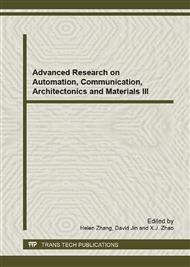p.264
p.268
p.272
p.276
p.280
p.287
p.295
p.299
p.303
Research on Tension Control with Fuzzy PID Control in the Low Relaxation PC Strand Wire Based on Mechanical Automation
Abstract:
The wire drawing quality fit and unfit quality, mainly rely on the wire drawing production line tension control is good or bad. According to the drawing process has a "lag", "nonlinear" features ,proposed uses the adaptive fuzzy PID control algorithm for ensuring a constant tension in the drawing process.Using the fuzzy control online real-time to adjust PID three controlled variable. In the MATLAB simulation, comparing with the conventional PID control to show that the fuzzy PID control of drawing tension system can maintain better constant.Keywords: Fuzzy adaptive PID, MATLAB-Simulink, Tension control, Mechanical automation
Info:
Periodical:
Pages:
280-286
Citation:
Online since:
August 2013
Authors:
Price:
Сopyright:
© 2013 Trans Tech Publications Ltd. All Rights Reserved
Share:
Citation:


